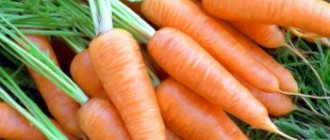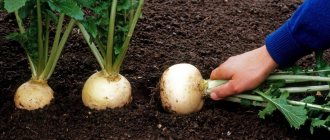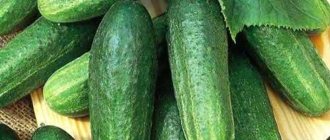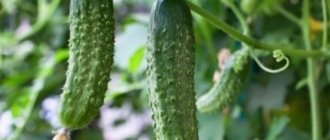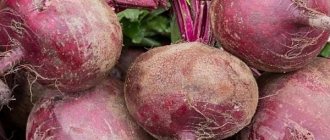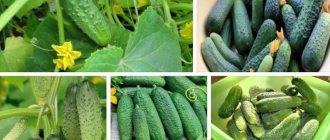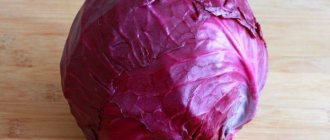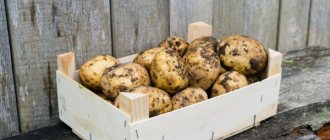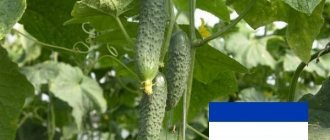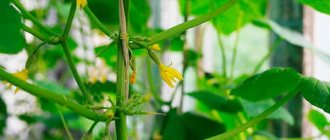Tasty, healthy cabbage is one of the key foods in the diet.
It is consumed fresh, and sauerkraut is one of the favorite dishes of almost every person. The popularity of cabbage forces breeders to develop varieties that can retain their nutritional and taste properties for as long as possible.
This article discusses the best varieties of cabbage for long-term fresh storage for the winter.
Amager 611
An old variety, which was included in the State Register back in 1943. At the same time, it can be grown throughout Russia, except for the northernmost regions (there are not enough short summers there).
Description of the hybrid:
The variety belongs to hybrids, therefore, the letter “F1” is always present on the packaging. Although, manufacturers from Ukraine, Kazakhstan and Moldova produce seeds without the letter “F1”. And when growing hybrids, it is impossible to obtain high-quality seeds of your own.
Amager cabbage ripens in 117 - 148 days. It has a semi-spreading rosette of leaves, while the leaves are raised from the ground (as if sticking out). The diameter of the rosette reaches 80 cm. The leaves are gray-green in color with a pronounced waxy coating. The leaves are 40 cm - 50 cm long.
The weight of the knuckles can be from 2.4 kg to 4 kg. At the same time, their shape is rounded and flat, and their structure is dense. The length of the stalk is 11 cm - 14 cm. By the way
, immediately after harvesting, the leaves on the cabbage are hard. But then, during storage, they become softer (juicier), and also, they lose the bitterness that occurs initially. Productivity per 1 sq. m plot can be from 6 kg, less rarely.
On a note!
Late varieties of cabbage, such as Amager, become better tasting and juicier during storage, therefore, many housewives ferment this cabbage in the winter (or maybe in the spring). Also, cabbage will be good for borscht and for stuffing (stuffed cabbage rolls).
Pros of cabbage:
- Frost resistance.
- Good shelf life (until summer).
- Transportability. The heads of cabbage are dense, therefore, they do not suffer from mechanical stress. Mechanical harvesting is possible.
- The yield is good and stable.
- Resistant to cracking. They do not crack, even in high humidity.
Minuses:
- Weakly resists fusarium, bacteriosis and gray rot (in storage).
- Bitterness immediately after harvesting (disappears during storage).
Moskovskaya late 15
Late varieties of cabbage, such as Moscow late 15, are considered an old and time-tested variety. It was bred by Soviet breeders back in 1937, and 6 years later in 1943, cabbage was included in the State Register. By the way
, cabbage can be grown in many regions of Russia, excluding the northernmost regions.
Characteristics of the variety
:
The variety is considered late and ripens within 115 - 140 days. And yet, it is a variety, not a hybrid, so you can get your own seeds from it.
The plant is powerful and spreading, where the leaf rosette spreads over a diameter of 90 cm - 110 cm. This means that it needs to be planted according to the scheme 70 x 80 cm or 80 x 80 cm. The leaves have a gray-green color, and also a faint waxy color raid. There is no characteristic waviness of the leaves, and they are smooth to the touch. By the way
, cabbage leaves have few leaf veins and are tough.
The variety grows up to 4 kg - 6 kg. Although the heads of cabbage can be 10 - 14 kg, you need to try for this. Harvest from 1 sq. m area is usually removed 6 kg - 10 kg. The heads of cabbage are round or rounded-flat in shape, where when cut you can see the white-yellow flesh. The inner stalk is small (up to 30 cm), but the outer stalk can be up to 30 cm. Important
. Due to the long outer stalk, the cabbage can fall on its side, so it needs to be hilled up more.
Cabbage is considered universal. It is suitable for fresh consumption (in salads), for preparing borscht and cabbage rolls, and is also suitable for fermentation. In the old days, cabbage was the best when pickled. By the way
, the variety can be stored for 5 - 6 months, and this is approximately until February. Also, cabbage has average transportability.
On a note!
Cabbage is demanding on soil and watering. She also has good immunity from diseases. And yet, the culture is not prone to cracking. By the way
, if you collect it after frost, then the cabbage becomes softer.
Wintering 1474
Wintering is considered an old and time-tested hybrid, which was bred by Soviet breeders in 1960.
The hybrid was developed from foreign varieties, but in 1963 it was entered into the state register. It is grown throughout Russia, except for the northernmost regions. Description of the hybrid
:
Wintering is a late hybrid of white cabbage that ripens in 120 - 150 days. And since it's a hybrid, we can't get our own seeds.
Cabbage has a small rosette of leaves that is semi-erect. Cabbage leaves are large, round in shape, and have a gray-green color. They are wrinkled and wavy at the edges. And yet, the leaves are covered with a waxy coating.
The heads of cabbage are round - flat with a dense structure, which can grow up to 2 kg - 3 kg. The inner stalk is medium-sized and can be eaten.
Zimovka cabbage is designed for pickling and long-term storage. Under optimal conditions, cabbage is stored until June. At the same time, marketability is 80 - 90%.
The benefits of cabbage
:
- This hybrid is suitable for growing in northern regions because it easily tolerates frosts of -6 °C.
- Also, cabbage tolerates short-term drought well.
- And yet, there are no special requirements for the soil, the main thing is that the soil is not acidic.
- Late varieties of cabbage, such as Zimovka, usually have excellent keeping quality. And under optimal conditions they can be stored for up to 8 months.
- The heads of cabbage are dense and juicy.
- The taste only improves with storage. Here, after 2 - 3 months, the bitterness disappears.
- And yet, the cabbage does not crack.
- It has excellent transportability because it is not afraid of mechanical stress.
- It resists well many diseases, such as spot necrosis and gray rot.
- Good yield (up to 7 kg per 1 sq. m), and at the same time it is stable.
Flaws
:
Fresh cabbage can be consumed only after 2 - 3 months. And this is because it tastes bitter when fresh. Then the bitterness disappears.
Crewmont F1
Krumont - created by our domestic breeders (scientists). It was entered into the state register in 1992. And this suggests that not only the Dutch can develop noteworthy varieties and hybrids. By the way
, the hybrid can be successfully grown throughout Russia, except for the northernmost regions.
Hybrid characteristics
:
The hybrid has a late ripening period, where ripening occurs in 160 - 170 days.
The rosette of leaves of this plant is compact in size. Here, the hybrid grows in height by 50 cm - 60 cm, while the cabbage can spread to a diameter of 60 - 75 cm. The leaves are up to 55 cm in length (small), and have a dark green color with a grayish tint. The leaves are smooth and their edges are wavy. Also, there is a waxy coating on the leaves.
Cabbage heads do not grow large, they can be only 1.9 kg - 2.1 kg. They are round-flat in shape and grayish-green in color. When cut, the heads of cabbage are white with a green tint. By the way
, the outer stalk can be up to 23 cm. And yet, Krumont has a good taste and yield (up to 5 kg per 1 sq. m of plot).
Pros of cabbage
:
- Late cabbage varieties such as Crumont F1 can resist diseases such as bacteriosis (both vascular and mucous), spot necrosis and fusarium.
- Excellent taste. Here, they only improve after 2 to 3 months of storage.
- The yield is high and at the same time stable (up to 5 kg per 1 sq. m).
- The purpose is universal. Suitable for both fresh consumption and processing.
- They do not require special approaches when growing.
- Cabbage is resistant to rotting processes.
- Transportability. The heads of cabbage are dense, so they are not afraid of mechanical stress.
Cons of a hybrid
:
So, the bitterness is overwhelming immediately after harvesting (it disappears after 2 - 3 months). And also, small heads of cabbage, and this is unusual for late varieties of white cabbage.
Features of long-term storage of cabbage for the winter
Cabbage for storage must be harvested before the onset of permanent frost. Then the vegetables need to be sorted, selecting the following heads:
- dense;
- without damage;
- with several green covering leaves;
- with an outer stalk 2–3 cm long.
Find out how to store cabbage in cling film in winter.
Cabbage should be stored in basements:
- in boxes;
- in containers;
- on wooden shelves;
- in bulk (in bins, sections);
- tied in pairs and hung on crossbars.
In regions with an abundance of snow, cabbage can be preserved by sprinkling it with snow and covering it with wooden shields or mats.
In the south, piles are used (ditches lined with straw or spruce branches and covered with them, as well as sprinkled with a thick layer of earth). Important! During storage, the heads of cabbage should not be in direct contact with the ground or tightly adjacent to each other. Otherwise, there is a risk of infecting them with fungus.
The rules for storing crops are as follows:
- temperature regime - 0°C...+2°C;
- air humidity - 85–90%;
- no light exposure;
- regular ventilation of the room;
- the storage area should be treated with a weak solution of potassium permanganate or soda and lined with straw;
- the heads must be laid with the stalk cuts facing up (so that drops of water do not get inside the head).
Kolobok F1
Kolobok F1 was bred by Russian breeders and entered into the state register in 2004.
Designed for cultivation in all regions of the Russian Federation. Description of the hybrid
:
The full growing season of cabbage is 145 - 165 days.
The rosette of leaves has compact dimensions, which is 30 cm - 35 cm in height and 45 cm - 55 cm in diameter. At the same time, the color of the leaves is dark green, and they are smooth to the touch. The edges of the leaves are wavy. Also, there is a waxy coating on the leaves.
The heads of cabbage usually grow dense, and their weight can be 3 kg - 4 kg, while the head is 15 cm - 20 cm in diameter. The shape of the cabbage is round, and when cut, the cabbage is whitish in color with a yellow tint. The outer stalk is of medium length, but the inner one is short.
The benefits of cabbage
:
- The purpose is universal. It can be eaten fresh (in salads), and can also be fermented and salted. But pickled bun is inferior to many other varieties.
- Keeping quality of the hybrid. Can be stored for up to 7 months, while 70% of the products are suitable for sale on the market. By the way
, after 6 months the cabbage is juicy and tasty, just like immediately after harvesting. - High yield. And this is, on average, 10 kg per 1 sq. m plot. At the same time, the yield is always stable.
- Late cabbage varieties such as Kolobok F1 have good immunity to many diseases.
- Also, Kolobok is not prone to cracking.
- And yet, it is portable. Here, it can be transported over long distances. The heads of cabbage are dense, so they are not afraid of mechanical stress.
Disadvantages of cabbage
:
- Cabbage does not tolerate lack of moisture well. Therefore, even short-term droughts are unacceptable for it. Important
. If you do not have the opportunity to constantly be present in the garden, then it is better not to plant Kolobok. - Weakly resists clubroot and cabbage fly.
- For this cabbage, the condition of the soil (fertility, acidity) is very important.
Valentina
Valentina is often planted in the gardens of summer residents living in the central part of the country. The variety was bred in Russia. It has a long ripening period, which can reach 6 months. The weight of the head does not grow more than 4 kg, but it is stored for a long time - 8 months.
Valentina cabbage is notable for its taste; many are delighted with the taste; this is the only reason why they plant the variety. It is formed due to its sugar content, crispy texture and fork-like firmness. Can be used in any direction from raw consumption to preservation.
Main advantages of the variety:
- Valentina is very tasty;
- Long shelf life;
- Ideal for pickling and other preservation.
Mara
Mara is a variety that was bred in Belarus. At the moment, it is rapidly spreading throughout Russia, although it has not yet been included in the state register of the Russian Federation. Important
. In Russia, the variety grows well everywhere except the most northern regions.
On a note!
This is not a hybrid, but a true variety, and you can get your own seeds from it if you wish.
Description of the variety
:
A late variety that ripens in 160 - 170 days.
The plant has a compact size. The rosette of leaves is not spreading, and the leaves are located low from the ground. The leaves are dark green in color and smooth to the touch. The edges of the leaves are slightly wavy. There is a waxy coating present.
Mara's kochni are round in shape and can grow up to 2.5 kg - 3.6 kg. At the same time, they are dense, and when cut, the cabbage has a whitish-yellowish color. Both stalks are medium in size.
Pros of cabbage
:
- Excellent keeping quality. They are stored for up to 8 months. At the same time, they retain a good presentation.
- High yield. They collect 8 kg - 10 kg from 1 sq. m of plot, while the yield is stable.
- Late cabbage varieties such as Mara have good immunity to disease. Although, there are modern hybrids that are better able to resist diseases. It's up to you to choose.
- Cabbage tolerates high humidity well. And even in this case, it does not crack.
- Good transportability. And this is because the heads of cabbage are dense. They can be collected, even mechanically.
- The purpose is universal.
Minuses
: So this means that you have to wait a long time for the harvest (up to 5 months).
Triumph
It takes a long time to ripen; the variety needs 175 days. Average weight is 4 kg. Summer residents often prefer it due to its quality indicators of keeping quality. Triumph remains fresh and usable for about 8 months.
Preservation of any type goes well with the variety, while the abundance of vitamin content is preserved even after processing. The heads of cabbage contain a lot of juice, the density of the leaves is small. The variety is resistant to Fusarium wilt. Has high productivity.
A correctly selected variety will allow you to obtain maximum yield, ensure the safety of the product, or achieve better taste.
Snow White
The late hybrid Snow White was bred by Ukrainian breeders. Here, scientists cross-pollinated such varieties and hybrids as Amager 611, Zimovka 1474, Denish Ballhead, Zimnyaya Gribovskaya 2176, Dauerweiss and, as a result, got Snow White. At first it was recommended for cultivation only in Ukraine and Kazakhstan. Currently, it is grown in the Central and Southern regions of the Russian Federation.
On a note!
This is a hybrid and you won’t be able to get your own seeds from it.
Hybrid characteristics
:
The full growing season of cabbage is 127 - 150 days.
Cabbage has a fairly powerful leaf rosette. Which in diameter can be from 70 cm. Its leaves are of medium size, which have a gray-green color. Also, there is a waxy coating. To the touch, the surface of the leaf is slightly wrinkled, while the edges of the leaf plate are smooth or wavy. The number of veins in the leaves is small.
Cabbage heads grow to sizes from 3 kg to 5 kg. When cut, you can see white flesh. Like most other late varieties, Snow White pleases us with good harvests.
The benefits of cabbage
:
- Frost resistance. Late cabbage varieties such as Snow White have enviable frost resistance. Even when the temperature drops to - 5 ° C - 10 ° C, the cabbage does not spoil (but it is better not to do this).
- The purpose is universal. Cabbage can be eaten fresh, pickled, pickled, and various dishes can be prepared from it.
- The heads turn out to be quite large and juicy, which means that the cabbage needs a lot of moisture.
- Resistant to cracking.
- Transportability. The heads of cabbage are dense, so they are not afraid of mechanical stress.
- Keeping quality. Cabbage can be stored for 6 - 8 months. But this is only subject to optimal conditions.
- Productivity. The cabbage harvest can be from 4.7 kg to 7.5 kg, and this is all from 1 sq. m plot. Although, the results may be better if you take better care of it (feeding, watering, crop rotation).
Disadvantages of cabbage
: This includes average disease resistance, as well as late ripening. Although, it depends on who.
Langedijker
This is an old German variety that people slowly began to forget.
It is overshadowed by modern hybrids, which can be much tastier, healthier or have better shelf life. But there are still admirers of the variety who appreciate its merits. Description of the variety
:
Late varieties of cabbage, such as Langedijker, are considered late-ripening and ripen in 140 - 170 days.
The plant reaches a height of 40 cm. The leaves are dark green. When cut open, you can see white flesh. Which contains up to 10% dry matter, as well as a lot of ascorbic acid and beta carotene.
Langedijker heads grow up to 2 kg - 4.4 kg (on average). They can be either oval or round in shape. The consistency of the heads of cabbage is dense, and their color is dark green.
Pros of cabbage
:
- Productivity of the variety. From 1 sq. m of plot you can get 8 kg - 10 kg of cabbage.
- The purpose is universal. This means that it can be eaten fresh (in salads), pickled, pickled and salted. Also, various dishes are prepared from cabbage (stuffed cabbage rolls, cabbage soup, preparations).
- Transportability. Because cabbage is dense, it can be transported. Because she is not afraid of mechanical influences.
- Heads of cabbage are not prone to cracking.
- Langedijker is especially resistant to bacteriosis (mucosal and vascular).
- Long-term storage. And this is until May, without loss of taste.
Let's highlight from the minuses
: Cabbage does not tolerate shade.
How to determine the suitability of cabbage for pickling by appearance
Having chosen the “right” varieties for fermentation, you need to provide them with proper care. The variety may be the best for pickling, but due to violations of agricultural technology, the heads of cabbage will turn out loose and tasteless.
Selecting heads of cabbage for pickling:
- the best weight of cabbage heads is 2-3 kg, “baby” forks will not work;
- when you press on the fork, it does not bend or lose its shape;
- when pressed, you can hear the creaking of the leaves, which is a sign of a high density of the head of cabbage;
- the outer leaves should be white or slightly greenish;
- The cabbage should taste sweet, without bitterness.
- stalk length – no more than 3-4 cm.
Early cabbage, specimens affected by pests, and those with rot are not suitable for processing. Some late varieties have a slightly bitter taste. This is cabbage for long-term storage; the bitterness goes away over time. But such varieties are not recommended for pickling and pickling.
Turkiz
The Turkiz variety was developed in Germany.
And it has some advantages that other varieties and hybrids do not have. For example, Turkiz can easily survive drought. Description of the variety
:
Late varieties of cabbage, such as Turkiz, are late-ripening and ripen in 150 - 165 days.
The plant has a powerful bush, with a good root system. And this allows the plant to easily survive droughts.
Cabbage heads can be from 2 kg to 4 kg. Their color can be dark green. Their shape is smooth and round. The taste of kochoch is sweetish, but it is also juicy.
The benefits of cabbage
:
- Strong immunity. Cabbage has “innate immunity” from any bacteriosis (mucosal and vascular), from phomosis, clubroot and fusarium wilt. Therefore, Turkiz rarely gets sick and this is the main plus.
- Drought resistance. A good root system contributes to this.
- Versatility in use. Here, you can eat cabbage fresh, pickled, pickled, salted, and it can also be used to prepare various dishes.
- Good yield. From 1 sq. m area usually remove 8 kg - 10 kg of high-quality forks.
- Excellent taste. Turkiz has a sweetish taste, while the cabbage is juicy. Also, cabbage contains many useful substances, especially ascorbic acid (vitamin C). By the way, there is no bitterness in it, which is present in many varieties and hybrids.
- Excellent keeping quality. Here, cabbage can be stored for at least 6 months. But this is provided that optimal storage conditions are observed.
- Cabbage is well transported over long distances. And this is possible because it is dense. By the way
, Turkiz can be harvested mechanically. - Turkiz will survive any stressful situations (temperature changes, droughts, rains) with dignity.
The disadvantage of cabbage is its intolerance to shade.
How to choose a variety
The best option is late-ripening cabbage varieties characterized by the following characteristics:
- Increased stability under harsh environmental conditions (frost and temperature changes).
- Excellent yield.
- Resistant to common diseases and pests.
- Density and large size of heads of cabbage (the weight of one can be 6-7 kg).
- Good shelf life and subsequently improved taste.

